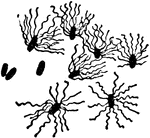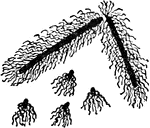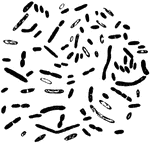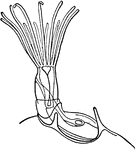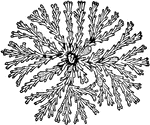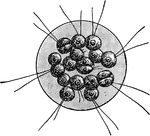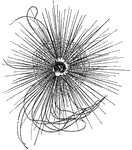The Microorganisms gallery offers 177 images of microbiology and several types of microorganisms. Microorganisms, also known as microbes, are organisms that are microscopic, and are usually too small to be seen by the naked human eye.
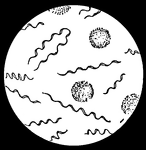
Spirochaeta Obermeieri, Bacteria
Illustration of magnified Spirochaeta obermeieri. This genus of bacteria have "the cells united in long…
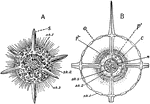
Actinomma
"Actinomma, a radiolarian with a shell and no mouth. A, whole animal with a portion of two spheres of…
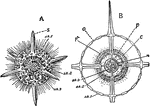
Actinomma Asteracanthion
"Actinomma Asteracanthion, a Radiolarian with a limited number of specialized radii (axes), symmetrically…

Alveolina Ovoidea (d'Orbigny)
"The Foraminifera are enclosed in minute calcareous shells, early invisible to the naked eye; they are…

Amaeba Proteus
"Amaeba proteus; B, Amaeba radiosa. n, nucleus. c, contractile vacuole. a, food engulfed. ec, one of…

Animalcule
"A term etymologically applicable to any very small animal, and limited in actual use to those which…
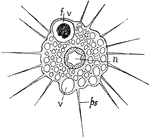
Sun Animalcule
"Actinophrys sol (Sun animalcule). n., nucleus; f.v., food vacuole; v., contractile vacuole; ps., pseudopodium."…

Trumpet Animalcule
"They are trumpet-animalcules of the family Stentoridae, with the peristome divided into two lappet-like…
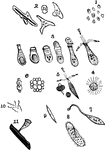
Forms of the animalcules, magnified
"Fig. 1, Monads; 2, Forms assumed by the Ameoba; 3, Flask Animalcules, Enchelis; 4, Actinophrys sol;…

Diagram of an Annulosa
A diagram of an annulosa showing its external skeleton made up of segments or rings arranged along a…

Ascocarp
This illustration shows further development of the ascocarp: A, sectional view, showing the branches,…
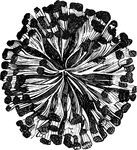
Flustra, avicularia
"The common Flustrae, or Sea-mats, are flat and foliaceous in their form, presenting…
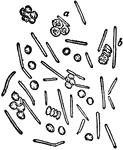
Bacillus Anthracis
"Bacilli mingles with blood-corpuscles from the blood of a guinea-pig; some of the bacilli dividing."…
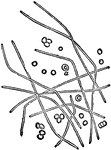
Bacillus Anthracis
"The rodlets after three hours' culture in a drop of aqueous humour. They grow out into long leptothrix-like…
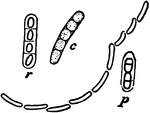
Bacillus Megaterium
"A chain of motile rodlets still growing and dividing (bacilli)." — The Encyclopedia Britannica,…
Bacillus Megaterium
"A pair of bacilli actively growing and dividing." — The Encyclopedia Britannica, 1910

Bacillus Megaterium
"A rodlet in this condition (but divided into four segments) after treatment with alcoholic iodine solution."…

Bacillus Megaterium
"Successive stages in the development of the spores." — The Encyclopedia Britannica, 1910
Bacillus Megaterium
"A rodlet segmented in four, each segment containing one ripe spore." — The Encyclopedia Britannica,…
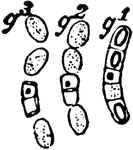
Bacillus Megaterium
"Early stages in the germination of the spores (after being dried several days)." — The Encyclopedia…

Bacillus Megaterium
"Successive stages in the germination of the spore." — The Encyclopedia Britannica, 1910
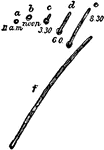
Bacillus Ramosus
"The various phases of germination of spores of Bacillus ramosus, as actually observed in hanging drops…
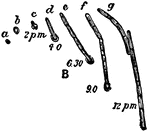
Bacillus Ramosus
"The various phases of germination of spores of Bacillus ramosus, as actually observed in hanging drops…
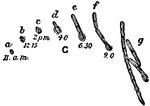
Bacillus Ramosus
"The various phases of germination of spores of Bacillus ramosus, as actually observed in hanging drops…

Bacillus Ramosus
"The various phases of germination of spores of Bacillus ramosus, as actually observed in hanging drops…

Bacillus Subtilis
"Bacillus subtilis, Cohn, and Spirillum undula, Ehrenb." — The Encyclopedia Britannica, 1910
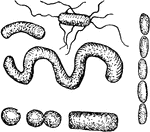
Bacteria
Harmless bacteria so numerous in drinking water that a person often takes a half-million into his stomach…
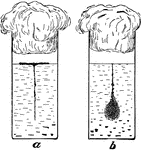
Grown Bacteria
Image A is of bacteria that needs air to grow. Image B is of bacteria that do not need air to grow.
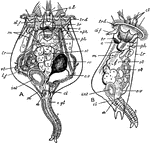
Brachionus Rubens
"Brachionus rubens. A, from the dorsal aspect; B, from the right side. a, anus; br, brain; d. f. dorsal…
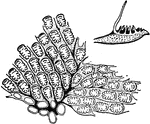
Bryozoan
A modern Bryozoan, a group of cells or zooecia seen from above, and a single cell seen from the side.

Calcarina Calcitrpoides (Lamarck)
"The Foraminifera are enclosed in minute calcareous shells, early invisible to the naked eye; they are…

Cassidulina Laevigata
One group will take the spherical form and produce a shell in the shape of the nautilus. In this case,…

S. Cerevisiae Cell Multiplication
"Various stages of cell multiplication by budding of Saccharomyces cerevisiae." -Stevens, 1916

Cercomonad Flagellate
"A colony of Cercomonas termo, a typical flagellate infusorian." -Whitney, 1911

Clostridium
"Germination of spore of Clostridium butyricum—the axis of growth coincides with the long axis…

Cluster-Cups on Barberry (Lower Side)
These are very destructive parasites that attack valuable crops. Cluster-cups are orange-colored spores…
Cocci
"A chair of cocci of Leuconostoc mesenterioides, with two "resting spores," i.e. anthrospores." —…

Coccidium
"Life history of Coccidium. 1. Sporozoite; 2. Sporozoite entering a cell and becoming a trophozoite;…
Dentalina Subarcuata
"The shell advances beyond this simple type by a process of linear budding, the first cell being spherical,…

Dinoflagellates
"Various forms of Dinoflagellata. 1. Glenodinium 2. Ceratium 3. Prorocentrum 4. Polykrikos. 2 shows…
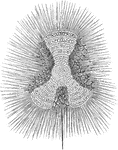
Euchitonia
"A pelagic family of radioflagellate infusorians, typified by the genus Euchitonia. The animalcules…
Euglena
Euglena viridis is a species of unicellular protists in the Euglenaceae family of flagellate organisms.

Euglena Viridis
"A, Euglena viridis, a flagellate Infusorian. I, typical swimming condition; 2, somewhat contracted;…

Euglena Viridis
"Euglena viridis. A-D, four views illustrating euglenoid movements; E and H, enlarged views; F, anterior…
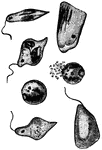
Euglena Viridis
"This is the most common species of the Euglenia, and is among the most widely diffused of…

Fabularia Discolithus (Defrance)
"The Foraminifera are enclosed in minute calcareous shells, early invisible to the naked eye; they are…
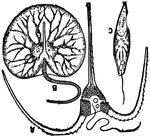
Flagellata
Flagellata is an order of Protozoa characterized by the presence of flagellae (whip-like structures…
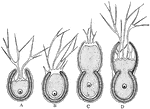
Foraminifer Shell Formation
"Formation of shell in a simple Foraminifer. In A the shell has one chamber; B, C, and D show the formation…

Diagrams of Foraminifera
"Diagrams of Foraminifera. A, monothalamian; B, C, polythalamian; D, horizontal, and E, F, vertical…
